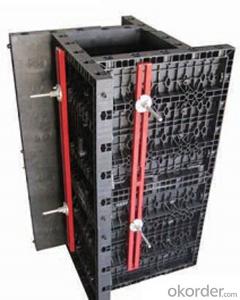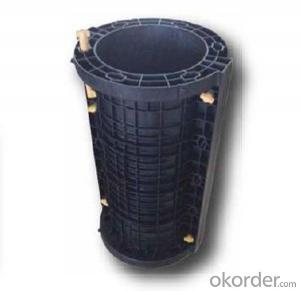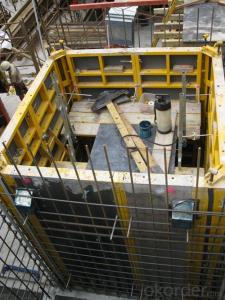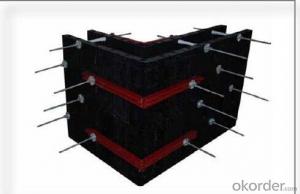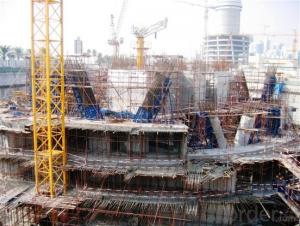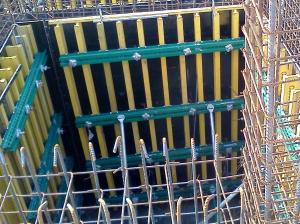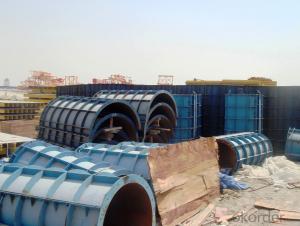QES Scaffolding Formwork Scaffolding Wall Tie with Low Price
- Loading Port:
- Tianjin
- Payment Terms:
- TT OR LC
- Min Order Qty:
- 10000 set
- Supply Capability:
- 50000 set/month
OKorder Service Pledge
OKorder Financial Service
You Might Also Like
QES Scaffolding Formwork Scaffolding Wall Tie with Low Price
Scaffolding For High-Rise Buildings Formwork Scaffolding Truss High Quality
Frame Scaffolding Systems Formwork Bs Standard Scaffolding Tube With Low Price
Developing with new technology materials, steel formworks is no longer a must in construction concrete process. More and more buildings are established with plastic formworks. And workers love this new formworks much more.
The advantages of plastic formworks:
QES Scaffolding Formwork Scaffolding Wall Tie with Low Price
1.First of all--light
Yes it is the first advantage of plastic formwork. It wins the great praise of both contractors and workers.
The biggest panel is 120×1500px,weights 10.5kg only. It can be lift and set up by one person easily, which means there is no need for cranes on site.Saves a lot of cost and time.
2.Easy set up
Different size of panels can firmly locked by simply turn the special handles to 90 degree. The Panels has rib on the back, which makes the system need not traditional wood blocks and nails. The panels have holes to fit tie rod, guarantee the strength of the whole system.
3.Modularity
Modular formworks composed by different size of panels,the main item is 120×1500px panel,which is used for the large area of walls and slabs. There are also small size of panels like 10×1500px,20×1500pxcm,25×1500px,inner corner 20×20×1500px and outer corner 10×5×1500px.Due to the variety of panel size, the system can form almost all size walls 120×1500px panel of multiply by 125px. The material of modular formwork is PC-ABS mixed with special glass fibers which enable panels to hold high pressures.
4.Strength
The handles are made by high strength Nilon, each panel locked by at least 4 handles, which makes the whole system strong enough to pour 1000px walls.
5.Environment friendly
The system needs no cut and nail due to the variety size. Also it needs nearly no wood. The material can be recycled after broken, so it will not pollute the environment.
6.Consequent
Concrete does not stick to plastic formwork, thus the panels need no oil before using, and can be cleaned simply by water. The surface of the wall which build by modular formwork is smooth and without rework.
QES Scaffolding Formwork Scaffolding Wall Tie with Low Price
QES Scaffolding Formwork Scaffolding Wall Tie with Low Price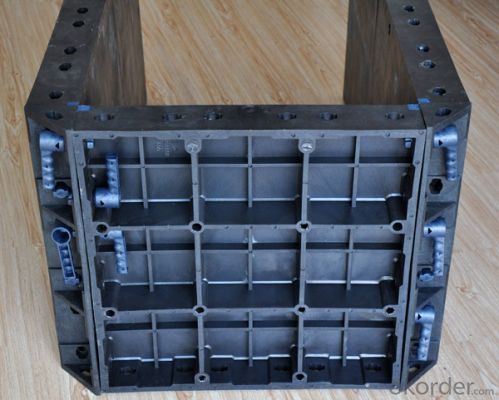
QES Scaffolding Formwork Scaffolding Wall Tie with Low Price
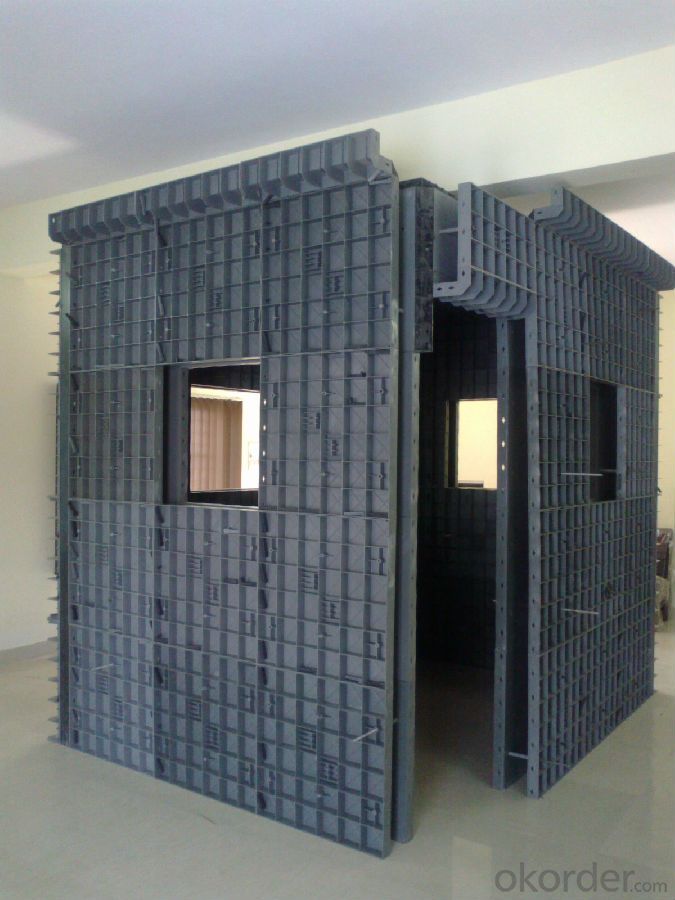
QES Scaffolding Formwork Scaffolding Wall Tie with Low Price

Advantage
* Good loading capacity
* Easy to assemble and dismantle
* Stable and durable thanks to its structual design & automatic welding quality
* Customized solution helps you work safe, save cost and convenient
* Excellent quality for formwork & scaffolding with wide choices
Packing
in bulk or in bundle, or as requested
Shipping
15-20 Days.
Normally small orders, it needs just 15-20 business days to the port. For goods with stock, it would be even shoter.
QES Scaffolding Formwork Scaffolding Wall Tie with Low Price
Other scaffolding & formwork products:
(1) Scaffolding System:
Including Ringlock Scaffolding System and accessories; Cuplock Scaffolding System and accessories; Kwikstage Scaffolding System and accessories; Haki Scaffolding System and accessories;
(2) Scaffolding Frame & Accessories:
Including Walk Through Frame Scaffolding; Ladder Frame Scaffolding; Accessories; we also can make scaffolding according to your samples or drawings.
(3) Scaffolding Couplers/Clamps:
We can produce all kinds of forged and pressed couplers, including British type couplers, American type couplers, German type couplers, Italian type couplers ,fence couplers, BRC coplers and so on. We also can produce according to your drawings or samples.
(4) Formwork System Scaffolding & Accessories:
Light Duty Shoring prop and Heavy Duty Shoring Prop; Wing nuts and Tie rods; RASTO clamp and so on.
FAQ QES Scaffolding Formwork Scaffolding Wall Tie with Low Price
Why Us?
We are one of the Top 500 in the world, largest construction materials supplier in China. Also we are a state-owned company and respond to every customer with large and also small orders.
We own professional manufacturers with powerful producing capacity.
Extensive and comprehensive quality control system
Excellent products with competitive prices.
Efficient services in pre and after sale.
Full energy with affluent experience team.
- Q:What are the different types of formwork hinges used with steel frame formwork systems?
- There are two main types of formwork hinges used with steel frame formwork systems: fixed hinges and adjustable hinges. Fixed hinges are used when the desired formwork angle does not need to be changed, providing a stable and rigid connection between formwork panels. On the other hand, adjustable hinges allow for flexibility in adjusting the formwork angle, making them suitable for projects with varying concrete structures. These hinges offer ease of use and versatility in formwork installation and removal.
- Q:Are there any specific safety regulations or standards for using steel frame formwork?
- Yes, there are specific safety regulations and standards for using steel frame formwork. These regulations and standards are put in place to ensure the safety of workers and the successful completion of construction projects. One of the primary regulations is the Occupational Safety and Health Administration (OSHA) standards. OSHA sets forth guidelines for the use of steel frame formwork to prevent accidents and injuries. These guidelines include requirements for proper training and certification of workers, the use of personal protective equipment (PPE) such as hard hats and safety harnesses, and the implementation of safety procedures such as fall protection systems and proper scaffolding. In addition to OSHA standards, there are industry-specific standards and codes that govern the use of steel frame formwork. For example, the American Concrete Institute (ACI) provides guidelines and standards for concrete formwork, including steel frame formwork. These standards cover aspects such as the design and construction of formwork systems, the use of proper bracing and shoring, and the inspection and maintenance of formwork. Furthermore, many countries have their own specific regulations and standards for using steel frame formwork. These regulations may vary depending on the jurisdiction and local building codes. It is important for construction companies and contractors to be aware of and comply with these regulations to ensure the safety and legality of their projects. Overall, using steel frame formwork requires adherence to specific safety regulations and standards. These regulations are in place to protect workers, prevent accidents, and ensure the quality and integrity of construction projects.
- Q:How does steel frame formwork help in reducing concrete bleeding?
- Steel frame formwork can significantly reduce concrete bleeding by providing a strong and stable structure for the concrete to be poured into. Steel formwork is designed with rigid panels and strong corners, which prevent the movement and displacement of the concrete during the pouring process. This stability minimizes the segregation and settling of the concrete components, including water, cement, and aggregates, which are the main causes of bleeding. The steel frame formwork also allows for precise control of the concrete flow and placement. The formwork panels can be adjusted and aligned accurately to create a tight seal and prevent any leakage or seepage of the concrete. This ensures that the concrete is contained within the desired area and doesn't flow or bleed excessively. Furthermore, steel formwork provides a smooth and even surface for the concrete to be poured onto. This reduces the chances of air bubbles getting trapped within the concrete, which can lead to bleeding. The smooth surface also allows for easier finishing and leveling of the concrete, minimizing the need for excessive vibration or troweling, which can contribute to bleeding. Overall, steel frame formwork plays a crucial role in reducing concrete bleeding by providing a stable structure, precise control of concrete flow, and a smooth surface for pouring. This helps to maintain the integrity and homogeneity of the concrete, resulting in a stronger and more durable structure.
- Q:How does steel frame formwork affect the overall cost efficiency of a project?
- Steel frame formwork can significantly enhance the cost efficiency of a project for several reasons. Firstly, steel frame formwork is highly durable and reusable, reducing the need for constant replacements and resulting in long-term cost savings. Secondly, its modular design allows for faster assembly and disassembly, accelerating construction timelines and reducing labor costs. Additionally, steel frame formwork offers excellent load-bearing capacity, enabling the construction of taller and larger structures, which optimizes space utilization and reduces material requirements. Overall, the use of steel frame formwork contributes to improved productivity, decreased construction time, and reduced material and labor expenses, thereby enhancing the overall cost efficiency of a project.
- Q:Is steel frame formwork suitable for the construction of bridges?
- Yes, steel frame formwork is suitable for the construction of bridges. Steel offers high strength and durability, making it capable of withstanding the heavy loads and forces exerted by bridge structures. Steel frame formwork also allows for easy customization and adjustment, making it an ideal choice for complex bridge designs. Additionally, steel formwork can be reused multiple times, making it a cost-effective option for bridge construction projects.
- Q:What are the different types of form ties used with steel frame formwork?
- There are several different types of form ties that are commonly used with steel frame formwork. These ties are essential for ensuring the stability and strength of the formwork system. Here are some of the different types of form ties used with steel frame formwork: 1. Welded Form Ties: These ties are made by welding a metal plate to one end of a steel rod. The plate is then attached to the formwork panels, providing a secure connection. 2. Coil Ties: Coil ties are a type of tie that has a coil-shaped end. These ties can be inserted into the formwork panels and twisted to provide a tight connection. 3. She-Bolt Ties: These ties consist of a threaded rod with a plate attached to one end. The rod is inserted through the formwork panel and secured with a nut, providing a strong and adjustable connection. 4. Flat Tie: Flat ties are made of flat metal strips that are inserted into the formwork panels. These ties are commonly used in smaller formwork applications. 5. Loop Ties: Loop ties are made of a metal rod with a loop at one end. These ties are inserted into the formwork panels and twisted to provide a secure connection. 6. Snap Ties: Snap ties are made of a metal rod with a loop at one end and a flat plate at the other end. These ties are inserted into the formwork panels and secured with a snap tie wedge, providing a quick and efficient connection. These are just a few examples of the different types of form ties that are used with steel frame formwork. The choice of tie will depend on factors such as the size and complexity of the formwork system, as well as the specific requirements of the construction project. It is important to select the appropriate form ties to ensure the safety and stability of the formwork structure.
- Q:Can steel frame formwork be used for curved or irregularly shaped structures?
- Yes, steel frame formwork can be used for curved or irregularly shaped structures. Steel frame formwork is highly versatile and can be easily customized to accommodate various shapes and sizes. It offers excellent flexibility, allowing it to be adjusted to fit the desired curvature or irregularity of the structure. Additionally, steel is a strong and durable material that can withstand the pressures exerted during the concrete pouring process, ensuring the stability and integrity of the formwork. Therefore, steel frame formwork is an ideal choice for constructing curved or irregularly shaped structures.
- Q:How does steel frame formwork affect the overall constructability of a concrete structure?
- The overall constructability of a concrete structure can be greatly enhanced by steel frame formwork. This formwork system comprises steel frames, typically made from steel beams or columns, which are utilized to bear the weight of the concrete during the pouring and curing process. One key advantage of steel frame formwork lies in its strength and durability. Steel possesses a high load-bearing capacity, enabling the formwork to withstand the pressure exerted by the wet concrete. Consequently, steel frame formwork allows for the construction of larger and taller concrete structures with ease, as it supplies the necessary support and stability. Moreover, steel frame formwork offers flexibility in terms of design and layout. The modular nature of the steel frames facilitates simple assembly and disassembly, rendering it suitable for various types of structures. This adaptability proves particularly advantageous when working on projects with intricate shapes or irregular layouts, as the formwork can be tailored to meet specific requirements. Furthermore, steel frame formwork enables faster construction times. The reusable nature of the steel frames permits easy transportation and reassembly at different locations, reducing the need for new formwork materials. This not only saves time, but also decreases construction costs. Additionally, the smooth surface of steel formwork allows for swifter and easier concrete pouring and finishing, resulting in shorter construction schedules. Another benefit of steel frame formwork is its ability to enhance the quality of the concrete structure. The rigid steel frames ensure precise alignment and dimensions, minimizing the risk of deformities or inconsistencies in the final structure. This contributes to improved overall aesthetics and structural integrity. To summarize, steel frame formwork has a positive impact on the overall constructability of a concrete structure due to its strength, durability, versatility, speed, and enhanced quality. Its capacity to support larger and more complex structures, combined with its ease of assembly and reusability, make it a favored choice for many construction projects.
- Q:How does steel frame formwork handle the pouring and curing of concrete?
- Steel frame formwork is a construction technique that uses steel frames to support and shape the pouring and curing of concrete. The steel frames are designed to be strong, rigid, and adjustable, allowing them to withstand the weight and pressure of the concrete during pouring. They provide a stable structure that ensures accurate alignment and positioning of the concrete, preventing any potential deformations or misalignments. Additionally, the steel frames are durable and reusable, making them cost-effective and efficient for multiple concrete pouring and curing processes.
- Q:What are the safety considerations when using steel frame formwork?
- When using steel frame formwork, there are several important safety considerations to keep in mind. First and foremost, it is crucial to ensure that the steel frame formwork is properly designed and constructed. This means that it should be able to withstand the loads and pressures exerted during the concrete pouring process. Any structural deficiencies or weaknesses in the formwork can pose a significant safety risk to workers. Additionally, it is important to train and educate workers on the proper assembly, installation, and dismantling procedures for the steel frame formwork. Workers should be familiar with the specific safety measures and precautions that need to be taken when using this type of formwork. This can include using appropriate personal protective equipment (PPE), such as helmets and safety harnesses, as well as understanding the correct procedures for securing the formwork to prevent any collapse or movement. Another safety consideration is the potential for falls from height. Steel frame formwork is often used in tall structures, such as multi-story buildings or bridges, which can present a fall hazard. It is essential to implement proper fall protection measures, such as guardrails or safety nets, to prevent workers from falling and sustaining serious injuries. Furthermore, it is important to regularly inspect the steel frame formwork for any signs of damage or deterioration. Any cracks, rust, or other defects should be promptly addressed to maintain the integrity and safety of the formwork. Regular maintenance and repairs are essential to ensure that the formwork remains in good condition and can continue to safely support the concrete pouring process. Lastly, communication and coordination among the construction team are key to ensuring safety when using steel frame formwork. Clear instructions and procedures should be established and communicated to all workers involved in the formwork installation and removal process. This can help minimize the risk of accidents and ensure that everyone is aware of their roles and responsibilities. Overall, by following proper design, training, inspection, and maintenance protocols, as well as implementing appropriate fall protection measures, the safety risks associated with using steel frame formwork can be effectively mitigated, providing a secure working environment for all construction workers involved.
1. Manufacturer Overview |
|
|---|---|
| Location | |
| Year Established | |
| Annual Output Value | |
| Main Markets | |
| Company Certifications | |
2. Manufacturer Certificates |
|
|---|---|
| a) Certification Name | |
| Range | |
| Reference | |
| Validity Period | |
3. Manufacturer Capability |
|
|---|---|
| a)Trade Capacity | |
| Nearest Port | |
| Export Percentage | |
| No.of Employees in Trade Department | |
| Language Spoken: | |
| b)Factory Information | |
| Factory Size: | |
| No. of Production Lines | |
| Contract Manufacturing | |
| Product Price Range | |
Send your message to us
QES Scaffolding Formwork Scaffolding Wall Tie with Low Price
- Loading Port:
- Tianjin
- Payment Terms:
- TT OR LC
- Min Order Qty:
- 10000 set
- Supply Capability:
- 50000 set/month
OKorder Service Pledge
OKorder Financial Service
Similar products
New products
Hot products
Hot Searches
Related keywords
